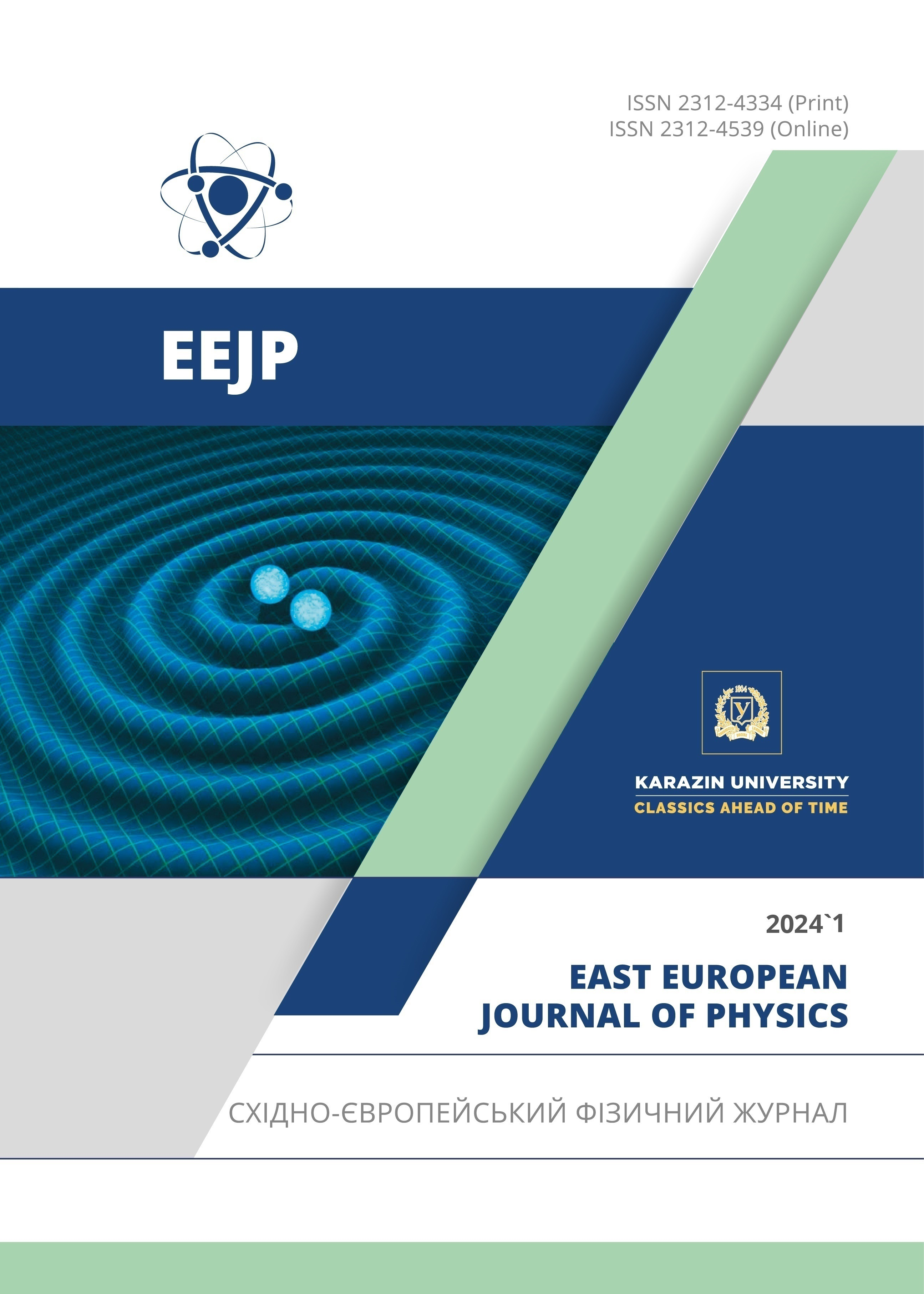Growing Sb2Se3 Films Enriched with Selenium Using Chemical Molecular Beam Deposition
Abstract
This study explores the growth of Sb2Se3 films on soda-lime glass (SLG) surfaces using the chemical molecular beam deposition (CMPD) method at a substrate temperature of 500°C. High-purity binary compounds, Sb2Se3 and Se, were employed as source materials for film deposition. Scanning electron microscopy (SEM) was employed to investigate the morphological characteristics of the Sb2Se3 films. Furthermore, the influence of temperature on the grain size and crystallographic orientation in selenium films was examined. Samples were obtained from a selenium source at temperatures of 370°C and 430°C. The results indicate that increasing the temperature of the selenium source results in the formation of larger grains and the presence of rod-shaped grains of Sb2Se3 aligned parallel to the substrate. A sample obtained at 370°C exhibited grains larger than 2 µm in size, evenly distributed across the substrate surface, indicating a uniform growth process. In contrast, when the temperature of the selenium source was raised to 430°C, considerably larger grains measuring approximately 4 μm were detected on the film surface substrate. X-ray diffraction analysis was conducted to gain insights into the crystalline phases and crystal structure of the Sb2Se3 films synthesized under different temperatures of the selenium source. The X-ray diffraction patterns displayed prominent peaks corresponding to the crystallographic planes (221) and (211), indicating the presence of strong crystalline phases. Additionally, peaks such as (020), (120), and (310) were observed in the X-ray patterns, further confirming the crystallinity of the films.
Downloads
References
A. Mavlonov, T.M. Razykov, F. Raziq, J. Gan, J. Cantina, Yu. Kawano, T. Nishimura, et al., “A Review of Sb2Se3 Photovoltaic Absorber Materials and Thin-Film Solar Cells,” Solar Energy, 201, 227 (2020). https://doi.org/10.1016/j.solener.2020.03.009
Y. Zhao, S. Wang, and C. Li, “Regulating deposition kinetics via a novel additive-assisted chemical bath deposition technology enables fabrication of 10.57%-efficiency Sb2Se3 solar cells,” Energy Environ. Sci. 15, 5118-5128 (2022). https://doi.org/10.1039/D2EE02261C
C. Wang, S. Lu, S. Li, S. Wang, X. Lin, J. Zhang, R. Kondrotas, et al., “Efficiency improvement of flexible Sb2Se3 solar cells with non-toxic buffer layer via interface engineering,” Nano Energy, 71, 104577 (2020). https://doi.org/10.1016/j.nanoen.2020.104577
Y, Zhou, L. Wang, S. Chen, S. Qin, X. Liu, J. Chen, D.-J. Xue, et al., Nature Photonics, 9(6), 409-415 (2018). https://doi.org/10.1038/nphoton.2015.78
A. Shongalova, M.R. Correia, J.P. Texeira, J.P. Leitão, J.C. González, S. Ranjbar, S. Garud, et al., “Growth of Sb2Se3 thin films by selenization of RF sputtered binary precursors,” Sol. Energy Mater. Sol. Cells, 187, 219-226 (2018). https://doi.org/10.1016/j.solmat.2018.08.003
E.A. El-Sayad, “Compositional dependence of the optical properties of amorphous Sb2Se3−xSx thin films,” Journal of Non-Crystalline Solids, 354(32), 3806-3811 (2008). https://doi.org/10.1016/j.jnoncrysol.2008.05.004
R. Kondrotas, J. Zhang, C. Wang, and J. Tang, “Growth mechanism of Sb2Se3 thin films for photovoltaic application by vapor transport deposition,” Solar Energy Materials and Solar Cells, 161, 190-196 (2017). https://doi.org/10.1016/j.solmat.2019.04.024
X.X. Wen, C. Chen, S.C. Lu, K.H. Li, R. Kondrotas, Y. Zhao, W.H. Chen, et al., “Vapor transport deposition of antimony selenide thin film solar cells with 7.6% efficiency,” Nat. Commun. 9, 2179 (2018). https://doi.org/10.1038/s41467-018-04634-6
X.B. Hu, J.H. Tao, S.M. Chen, J.J. Xue, G.E. Weng, K. Jiang, Z.G. Hu, et al., “Improving the efficiency of Sb2Se3 thin-film solar cells by post annealing treatment in vacuum condition,” Sol. Energy Mater. Sol. Cells, 187, 170-175 (2018). https://doi.org/10.1016/j.solmat.2018.08.006
D.B. Li, X.X. Yin, C.R. Grice, L. Guan, Z.N. Song, C.L. Wang, C. Chen, et al., “Stable and efficient CdS/ Sb2Se3 solar cells prepared by scalable close space sublimation,” Nano Energy, 49, 346-353 (2018). https://doi.org/10.1016/j.nanoen.2018.04.044
C.C. Yuan, X. Jin, G.S. Jiang, W.F. Liu, C.F. Zhu. “Sb2Se3 solar cells prepared with selenized dc-sputtered metallic precursors,” J. Mater. Sci: Mater. Electron. 27, 8906–8910 (2016). https://doi.org/10.1007/s10854-016-4917-3
S. Dias, B. Murali, and S.B. Krupanidhi, “Transport properties of solution processed Cu2SnS3/AlZnO heterostructure for low-cost photovoltaics,” Sol. Energy Mater. Sol. Cells, 143, 152-158 (2015). https://doi.org/10.1016/j.solmat.2015.06.046
F.I. Mustafa, S. Gupta, N. Goyal, and S. Tripathi, “Thin Films. In: Non-Ideal p-n junction Diode of Sb(x)Se(1-x) (x=0.4, 0.5, 0.6, 0.7) Thin Films,” AIP Conference Proceedings, 1393, 75-76 (2011). https://doi.org/10.1063/1.3653616
Copyright (c) 2024 Takhirdjon M. Razikov, Sultanpasha A. Muzafarova, Ruhiddin T. Yuldoshov, Zafarion M. Khusanov, Marg’uba K. Khusanova Z.S. Kenzhaeva, B.V. Ibragimova

This work is licensed under a Creative Commons Attribution 4.0 International License.
Authors who publish with this journal agree to the following terms:
- Authors retain copyright and grant the journal right of first publication with the work simultaneously licensed under a Creative Commons Attribution License that allows others to share the work with an acknowledgment of the work's authorship and initial publication in this journal.
- Authors are able to enter into separate, additional contractual arrangements for the non-exclusive distribution of the journal's published version of the work (e.g., post it to an institutional repository or publish it in a book), with an acknowledgment of its initial publication in this journal.
- Authors are permitted and encouraged to post their work online (e.g., in institutional repositories or on their website) prior to and during the submission process, as it can lead to productive exchanges, as well as earlier and greater citation of published work (See The Effect of Open Access).








